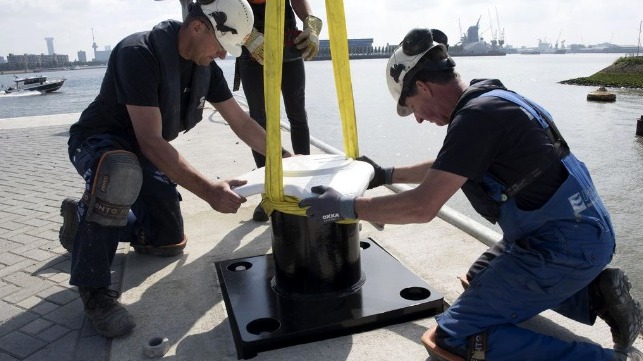First 3D-Printed Bollards Installed at Rotterdam as Technology Trial

The Port of Rotterdam Authority is installing the world’s first 3D-printed steel bollards as part of a renovation project for a section of the port. According to the port and its partner, the process permitted them to build them to manufacture the key element of the port infrastructure locally and could lead to the development of a broader program to facilitate the maintenance of port infrastructure locally.
“Traditionally, our bollards were always made from cast steel to a set design,” the Port of Rotterdam Authority said. “By applying 3D printing technology, bollards can not only be made faster, but they can also be made closer to the location where they are to be installed, which helps make production more sustainable.
The Port of Rotterdam Authority and RAMLAB developed the bollards together. They are being printed at RAMLAB using a technique which is called Wire Arc Additive Manufacturing (WAAM). It involves the robotic welding of layers deposited on top of each other to form a 3D shape.
“The results of external testing show that the new bollards are of at least the same quality as cast steel ones. Eventually, the original shape of the bollards will be redesigned to ensure that in the future they will be stronger and more durable,” port officials added.
The first six bollards are part of a series of twelve 3D-printed bollards that the Port Authority and RAMLAB have co-developed. The 3D printing of bollards is part of the infrastructure innovation program launched by the Port Authority to improve and increase sustainability in the manufacture and use of quayside hardware through scientific research, innovation, and digitization.
The port has also been using the new quay in the Sleepboothaven, where the bollards will be installed to moor vessels for Broekman Project Services, as an incubator for the innovative manufacturing industry, where students, the business community, and science work together to build the port of tomorrow. As part of its refurbishment of this area of the port, various innovative, sustainable building concepts are being applied. The quay wall was finished using precast concrete barrier elements that were installed without the need for a cofferdam, reducing the construction time.

that matters most
Get the latest maritime news delivered to your inbox daily.
“3D printing allows us to produce parts locally and on-demand,” said RAMLAB’s Managing Director, Vincent Wegener. “We are printing the first bollards, which is a useful test case that shows that you can produce small series relatively quickly when compared to casting and importing the parts from China.’
The Port of Rotterdam Authority sees the 3D printing of bollards as one step in the process of acquiring knowledge and experience of the potential this technology is set to bring. The next step will be to investigate the possibilities that 3D printing opens up for hydraulic engineering. One option that will be considered might be to develop a system of on-site 3D printing, which would allow on-site repairs to be carried out on nautical objects such as bollards and mooring posts.
